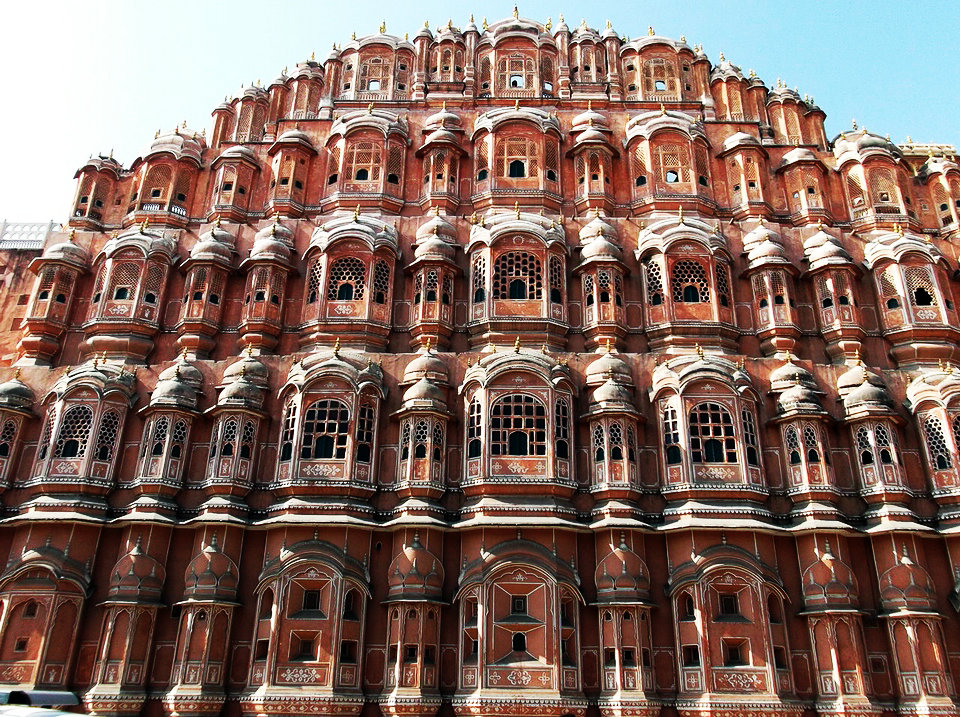Jharokha


A jharokha (Hindi: झरेखा Jharokha, eingedeutscht also Jaroka ) is a type of overhanging enclosed balcony used in the architecture of Rajasthan. It was also used in Indo-Islamic architecture. Jharokhas jutting forward from the wall plane could be used both for adding to the architectural beauty of the building itself or for a specific purpose. One of the most important functions it served was to allow women to see outside without being seen themselves. Alternatively, these windows could be used to position archers and spies.
The jharokha is a stone window projecting from the wall face of a building, in an upper story, overlooking a street, market, court or any other open space. It is supported on two or more brackets or corbelling, has two pillars or pilasters, balustrade and a cupola or pyramidal roof; technically closed by jalies but generally partly open for the inmates to peep out to see passing processions. The jharokha is more formal and ornamental than English or French “oriel” and is one of the most distinctive characteristics of the façade in medieval Indian architecture until the 19th century.
The projected balcony is an essential element of Rajasthani architecture, both as decoration and as a viewing platform. The chajjas – sloping eaves that projected out above the balconies – increase protection from both the summer sun and monsoon rain. Jharokhas are mainly used in palaces, havelis and temples.
History
Buddhism
Already on the – often elevated and open to the facade – lobbies ( mandapas ) of early Buddhist cave sanctuaries appear stone parapets ( vedikas ); these lobbies were often covered by rocky outcrops ( Kanheri Caves near Mumbai, Maharashtra ).
Hinduism
Early Indian timber structures have not survived, and so the oldest jharokhas appear on stone-built Hindu temples, with the early freestanding Indian temples ( Gupta temples, Talagunda, Amrol ) consisting of only one gella ( garbhagriha ) and one vestibule Do not know architectural elements yet. These arise only with the emergence of a temple integrated into the temple ( pradakshinapatha ). Among the earliest temple-lined temples are the Kalika Mata Temple in the Fort of Chittaur, Rajasthan or theLad Khan Temple in Aihole, Karnataka – both date back to around 700 AD At the late Pratihara Temple (eg at the Maladevi Temple in Gyaraspur, Madhya Pradesh ), around 875 AD This architectural element is already in full bloom. It continues at the temples of Khajuraho ( Lakshmana Temple around 950, Vishvanatha Temple around 1000, Kandariya Mahadeva Temple around 1030). It also appears on the largely open and air- filled Jain temples of the late period (Adinath Temple in Ranakpur, Rajasthan, around 1450).
Noteworthy is the fact that the originally vertical balcony railings evolve to slightly beveled components due to the emergence of stone benches inside, often using small turned stone columns, which can not deny their origin of wooden models.
Islam
After the extensive conquest of northern India by Islam, the Hindu and Jain temples came to a virtual standstill. On the other hand, the rulers of the Sultanate of Delhi and the later Mughal emperors jharokhas took over for their gate and palace buildings (eg Fatehpur Sikri ). In later times, the Hindu, but mogul faithful received Maharajas to the architectural style of their masters – in this way was one of the most magnificent jharokha facilities warehouse India: the Palace of the Winds’ ( Hawa Mahal ) in Jaipur. But also at many homes of wealthy merchants ( havelis ) occurjharokhas – especially in Rajasthan – as a dominant element of the facade design in appearance.
Source From Wikipedia